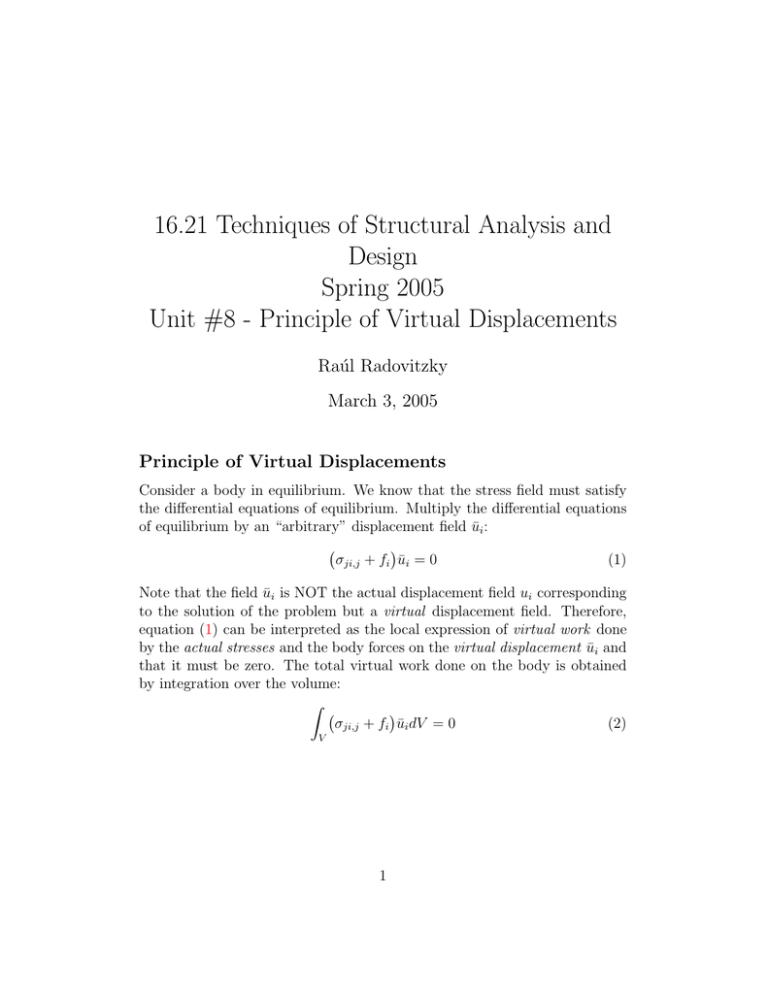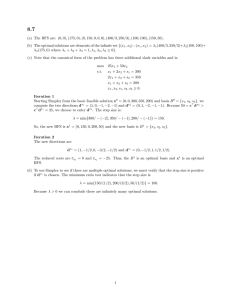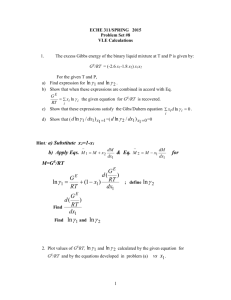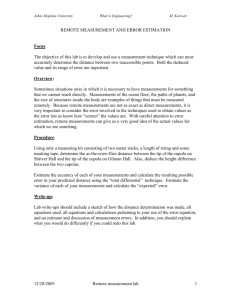Document 13475903
advertisement

16.21 Techniques of Structural Analysis and Design Spring 2005 Unit #8 ­ Principle of Virtual Displacements Raúl Radovitzky March 3, 2005 Principle of Virtual Displacements Consider a body in equilibrium. We know that the stress field must satisfy the differential equations of equilibrium. Multiply the differential equations of equilibrium by an “arbitrary” displacement field u¯i : � � σji,j + fi u¯i = 0 (1) Note that the field u¯i is NOT the actual displacement field ui corresponding to the solution of the problem but a virtual displacement field. Therefore, equation (1) can be interpreted as the local expression of virtual work done by the actual stresses and the body forces on the virtual displacement u¯i and that it must be zero. The total virtual work done on the body is obtained by integration over the volume: � � � σji,j + fi u¯i dV = 0 (2) V 1 and it must also be zero since the integrand is zero everywhere in the domain. � � σji,j u¯i dV + fi u¯i dV = 0 (3) V V � � �� � � σji u¯i ,j − σji u¯i,j dV + fi u¯i dV = 0 (4) V V � � � σji u¯i nj dS − σij �¯ij dV + fi u¯i dV = 0 (5) S V V The integral over the surface can be decomposed into two: an integral over the portion of the boundary where the actual external surface loads (tractions) are specified St and an integral over the portion of the boundary where the displacements are specified (supports) Su . This assumes that these sets are disjoint and complementary, i.e., S = Su ∪ St , S u ∩ St = ∅ � � σji ūi nj dS − ti ūi dS + St � Su (6) � σij �¯ij dV + V fi ūi dV = 0 (7) V We will require that the virtual displacements ūi vanish on Su , i.e., that the virtual displacement field satisfy the homogeneous essential boundary condi­ tions : ūi (xj ) = 0, if xj ∈ Su (8) Then, the second integral vanishes. The resulting expression is a statement of the Principle of Virtual Displacements (PVD): � � � σij �¯ij dV = ti u¯i dS + fi u¯i dV (9) V St V It reads: The work done by the external tractions and body forces on an ad­ missible (differentiable and satisfying the homogeneous boundary conditions but otherwise arbitrary) displacement field is equal to the work done by the equilibrated stresses (the actual solution of the problem) on the virtual strains (the strains produced by the virtual field). Example: Consider the bar under a tensile load shown in the figure: 2 E, A P x1 L The PVD applied to this case is: � � dū1 � dV = P ū1 � σ11 dx x1 =L 1 V � L � du1 dū1 � A E dx1 = P ū1 � dx1 dx1 x1 =L 0 � L � � � � � 2 d du1 d u1 � EA u¯ dx1 = P u¯1 � ū1 − 2 1 dx1 dx1 dx1 x1 =L 0 � L 2 � � � � � du1 du1 d u1 � EA ū1 − EA ū1 − EA u ¯ dx = P u ¯ 1 1� 2 1 dx1 dx1 dx x1 =L x1 =0 x1 =L 0 1 The second term on the left hand side is zero because we have asked that u¯1 = 0 at the support. Note we have not asked for any condition on u¯1 at x1 = L where the load is applied. � L 2 � � � du1 �� d u1 � EA ū1 dx1 − P ū1 � = EA � dx1 x1 =L dx21 x1 =L 0 The only way this expression can be satisfied for any admissible virtual dis­ placement field u¯1 is if: du1 �� P = EA � dx1 x1 =L and d2 u1 EA 2 = 0 dx1 which represent the equilibrium conditions at the boundary and inside the bar, respectively: � � du �� � 1 � P = A E = Aσ11 � � dx1 x1 =L x1 =L and � du1 � d d EA = σ11 = 0 dx1 dx1 dx1 3 The solution of this problem is: u1 (x1 ) = ax1 + b the boundary conditions are: u1 (0) = 0 ⇒ b = 0 P = Ea A P u1 = x1 EA �11 = P du1 = dx1 EA σ11 = E�11 = P A Example: With the exact solution of the problem of the bar under a tensile load, verify the satisfaction of the PVD for the following virtual displacement fields: • u¯1 = ax1 : � AE L P adx1 = P aL(?) 0 EA P aL = P aL q.e.d. • u¯1 = ax21 : � L P 2ax1 dx1 = P aL2 (?) EA 0 L2 � A � EP � 2a = P aL q.e.d. �E�A �2 AE Remarks: 4 • Principle of Virtual Displacements: – enforces equilibrium (in weak form) – enforces traction (natural) boundary conditions – does NOT enforce displacement (essential) boundary conditions – will be satisfied for all equilibrated solutions, compatible or in­ compatible Unit dummy displacement method Another application of the PVD: provides a way to compute reactions (or dis­ placements) in structures directly from PVD. Consider the concentrated reaction force at point �� 0�� of a structure in equilibrium under a set of loads and supports. We can prescribe an arbitrary admissible displacement field ūi and the PVD will hold. The unit dummy displacement method consists of choosing the virtual displacement field such that ūi (x0 ) = 1 in the direction of the reaction R0 we are interested in. Then the virtual work of the reaction is ū0 · R0 = |R0 . The PVD then reads (in the absence of body forces): � R0 · u ¯0 = σij �¯ij dV (10) V � R0 = σij �¯ij dV (11) V where �¯ij are the virtual strains produced by the virtual displacement field ū0 . Example: 5 E1 E2 A1 L1 A2 L2 E3 A3 L3 2θ v P Different materials and areas of cross section: E1 , E2 , E3 , A1 , A2 , A3 , but re­ quire symmetry to simplify the problem: E3 = E1 , A3 = A1 . For a truss element: σ = E� (uniaxial state). P v̄ = A1 L1 σ1 �¯1 + A2 L2 σ2 �¯2 + A3 L3 σ3 �¯3 Note: the indices in these expressions just identify the truss element number. The goal is to provide expressions of the virtual strains �¯I in terms of the virtual displacement v̄ so that they cancel out. From the figure, the strains ensued by the truss elements as a result of a tip displacement v are: � (L2 + v)2 + (L2 tan θ)2 − L1 �1 = �3 = L1 � 2 2 L2 (1 + tan θ) + 2L2 v + v 2 − L1 = L1 2 sin θ neglecting the higher order term v 2 and using 1 + tan2 θ = 1 + cos 2θ = cos2 θ+sin2 θ 1 = cos2 θ we obtain: cos2 θ � � � L22 L 1 + 2LL22 v − L1 1 + 2L v − L 2 1 2L2 v cos2 θ 1 �1 = �3 = = = 1+ 2 −1 L1 L1 L1 L2 were we have made use of the fact that: cos = L1 . We seek to extract θ the linear part of this strain, which should have a linear dependence on the 6 displacement v. This √can be done by doing a Taylor series expansion of the square root term 1 + 2x = 1 + x + O[x]2 (Mathematica tip: Taylor series expansions can be obtained by using the Series function. In this case: Series[Sqrt[1 + 2x], x, 0, 3]. L2 L2 �1 = �3 = 1 + 2 v − 1 = 2 v L1 L1 which is the sought expression. The expression for �2 can be obtained in a much more straightforward manner: v �2 = L2 Applying the constitutive relation: σI = EI �I we can obtain the stresses in terms of the tip displacement v: L2 L2 v σ1 = E1 2 v, σ3 = E3 2 v, σ2 = E2 L1 L1 L2 This expressions for the strains above also apply for the case of a virtual displacement field whose value at the tip is v̄. The resulting virtual strains are: L2 L2 v̄ ¯ �¯3 = 2 v, ¯ �¯2 = �¯1 = 2 v, L1 L1 L2 Replacing in PVD: v v̄ L2 L2 L2 L2 P v̄ = A1 L1 E1 2 v 2 v̄ + A2 L2 E2 + A3 L3 E3 2 v 2 v̄ � �� � L1 L1 � �� � L2 L2 � �� � L1 L1 � �� � ���� � �� � ���� � �� � ���� As expected the v̄’s cancel out, as the principle must hold for all its admissible virtual values and we obtain an expression of the external load P and the resulting real displacement v. This expression can be simplified using: L2 = L1 cos θ = L3 cos θ: A3 E3 L23 cos2 θ v A1 E1 L21 cos2 θ + v P = v + A2 E2 L31 L2 L33 � A E cos2 θ A E A3 E3 cos2 θ � 1 1 2 2 P = + + v L1 L2 L3 � �v P = (A1 E1 + A3 E3 ) cos3 θ + A2 E2 L2 P L2 v= (A1 E1 + A3 E3 ) cos3 θ + A2 E2 7 Example: P/2 u0 E1, A1 E2, A2 P/2 L2 L1 PVD: P u¯0 = A1 L1 σ1 �¯1 + A2 L2 σ2 �¯2 u0 u¯0 �1 = , σ1 = E1 �1 , �¯1 = L1 L1 u0 u¯0 �2 = − , σ2 = E2 �2 , �¯2 = − L2 L2 (−u0 ) (−¯ u0 ) u0 u¯0 + A2 L2 E2 P u¯0 = A1 L1 E1 L1 L 1 L2 L2 �A E � A2 E2 1 1 P = + u0 L1 L2 8







